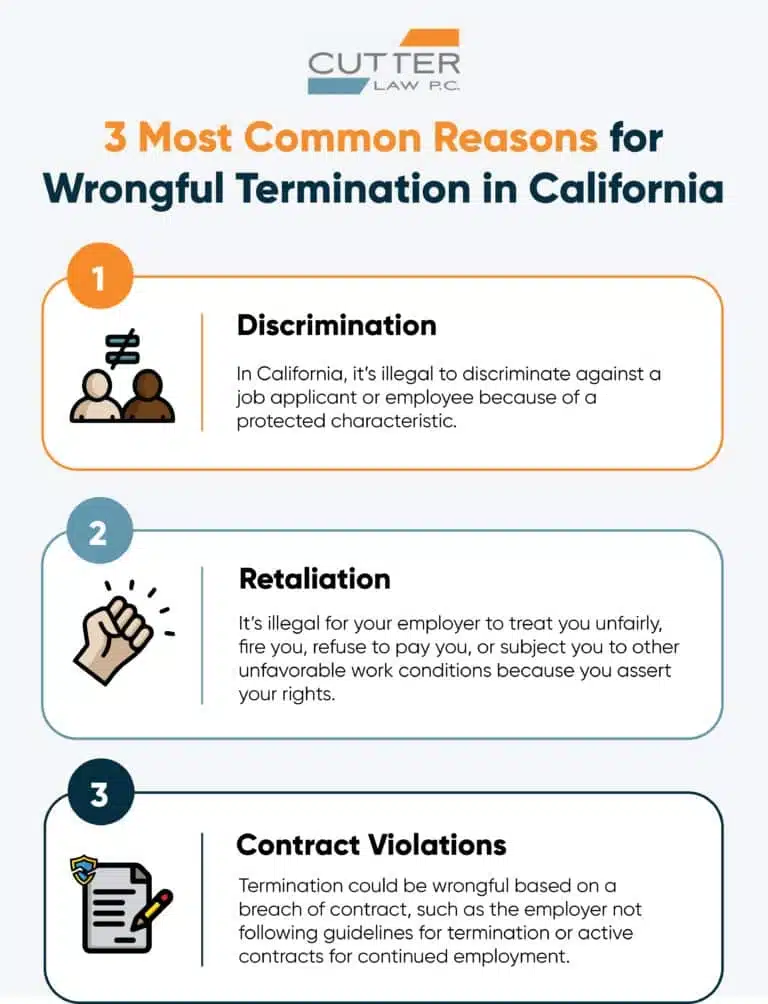California Wrongful Termination Laws
Understanding wrongful termination in California helps workers protect their rights. Even if you love your job and feel like your employer would never fire you without just cause, it’s still essential to understand the rights and laws protecting your employment status.
As you delve into California law on wrongful termination, you’ll learn about concepts like “at-will employment” and exceptions to at-will employment. You’ll also learn about the illegal actions an employer may take, which could be grounds for a wrongful termination lawsuit.
Wrongful termination is when an employer fires an employee illegally. Examples of wrongful termination could include violating anti-discrimination laws, breach of contract, or retaliation against an employee acting as a whistleblower. Our skilled California employment law attorneys can help protect your rights and explore your legal options.
Understanding At-Will Employment in California
According to California Labor Code § 2922, California is an “at-will employment” state, which means that an employer may terminate any employee at any time and that an employee may terminate their employment at any time.
Certain firings, however, may run afoul of the law, and the California Labor Code gives employees options for suing their employer for wrongful termination.
"*" indicates required fields
Common Grounds for Wrongful Termination in California
Multiple reasons exist for illegal firings with common causes, including those that violate anti-discrimination laws, cross the line into harassment or retaliation, and those which punish employees for taking protected time off or sick leave.
Contract-Based Exceptions To The At-Will Employment System
Contract-based violations fall under public policy exceptions, implied contract exceptions, and good faith exceptions. California Labor Code § 1102.5 describes exceptions to the at-will employment doctrine where an employee’s termination is considered a violation of public policy law.
The Bureau of Labor Statistics shares that a plaintiff – or employee – must show that their employer violated a policy within state or federal law. The violation must occur against a well-established public policy.
An example would occur when an employee files a workers’ compensation claim, leading to the employee’s termination by the employer. California Code of Civil Procedure 335.1 gives employees two years to file their lawsuit before the statute of limitations expires.
Another contract-based exception is the implied contract exception, which the court explains in California Supreme Court, (1988) 47 Cal.3d 654 or Foley v. Interactive Data Corp. (1988) 47 Cal.3d 654. The implied contract exception is applied when no express or written contract exists between an employee and an employer, but an implied contract does through conversations or written communications.
The implied contract may include details about job security and the step-by-step process used by the employer to fire an employee. In California Code of Civil Procedure 339, the state gives plaintiffs two years to file their lawsuit when they believe their former employer violated the implied contract exception for wrongful termination.
The third contract-based exception is the covenant of good faith and fair dealing exception, which requires that neither party in the contract does anything to prevent the other from receiving the full benefits of the contract.
This concept first appeared in a landmark case in 1949, Brown v. Superior Court (1949) 34 Cal.2d 559, where a husband and wife agreed to leave their property to each other, and then to the other’s heirs in the event of either one’s passing. After the husband died and left his property as agreed, the wife remarried and revoked her will to distribute her assets to her new husband.
That 1949 case would influence future lawsuits like Lawrence M. Cleary v. American Airlines, Inc. The plaintiff alleged that his employment contract contained an implied-in-law covenant of good faith and fair dealing.

Whistleblower Protections
California Labor Code § 1102.5 outlines the state’s primary whistleblower protections, and the Division of Labor Standards Enforcement offers a concise document on the protections whistleblowers enjoy under California law. The state provides specific whistleblower laws that protect employees, like the Sarbanes-Oxley Act, which prevents employers from terminating employees when they report securities fraud.
California Government Code § 12652 is another whistleblower statute that allows employees to file qui tam suits against their employers. Qui tam lawsuits occur when a whistleblower files a claim against another party on behalf of the government and are permissible under The California False Claims Act.
Examples of qui tam lawsuits include the following:
- Giving or taking a kickback for a referral
- Knowingly presenting false claims for services
- Falsely billing for services not given
California Government Code § 12653 defines protections for employees who file qui tam lawsuits. Employees, contractors, or agents have three years to bring qui tam lawsuits against another party before the statute of limitations expires.
Discrimination Protections
The Department of Fair Employment and Housing (DFEH) enforces employment discrimination laws. California Government Code § 12940 is the Fair Employment and Housing Act for California. This law prohibits employers from terminating employees based on protected characteristics like race, sexual orientation, and military status.
The following are protected characteristics:
- Race or ethnicity
- Ancestry or national origin
- Religion or creed
- Age (when 40 or older)
- Mental or physical disability
- Sex or gender
- Sexual orientation
- Gender identity
- Medical condition
- Genetic details
- Marital status
- Veteran or military status
The Labor Commissioner and the California Department of Industrial Relations handle further discrimination protections for employees that prohibit retaliation and discrimination. The state houses its retaliation and discrimination laws within the California Labor Code. Employees have three years to file their lawsuits, according to California Government Code § 12960.
Constructive Discharge Protections
Constructive discharge in California treats the act of quitting a job the same as having been fired, which can benefit an employee by making them eligible for legal rights under wrongful termination law.
An example of this protection is Brady v. Elixir Industries (1987) 196 C.A.3d 1299. The court recognized that an employer might fire an employee through tortious discharge despite not having actually terminated the employee.
Another example exists in Turner v. Anheuser-Busch, Inc. (1994) 7 Cal.4th 1238, 1251-52. The court found that an employee failed to prove that he experienced “intolerable aggravated conditions” while at his job or that his employer violated the law.
Mass Layoff Notification Protections
Employers must give their employees 60-day notice before conducting a mass lay-off when that action will impact at least 50 employees within 30 days, according to California Labor Code § 1401.
The Worker Adjustment and Retraining Notification (WARN) details the laws that guide notification requirements. California Code of Civil Procedure 339 gives employees three years to file a lawsuit based on WARN laws.

Steps To Take When You Have Been Terminated In California
A wrongful termination lawsuit might not be the first thing on your mind when your employer fires you without just cause, but the short time to meet the California wrongful termination statute of limitations on lawsuits means you should speak with a law firm like Cutter Law P.C. swiftly.
California Code of Civil Procedure 338 gives you the option to file a complaint for retaliation or discrimination with the California Labor Commissioner and the Labor Commissioner’s Office.
Steps the government takes in retaliation and discrimination complaints include the following:
- The employee files the complaint within one year of the adverse action.
- The commissioner’s office reviews the complaint.
- The commissioner completes an initial investigation.
- The office conducts three interviews with the complainant.
- A hearing occurs (in a limited number of cases).
- The commissioner’s office produces a final determination letter.
The process doesn’t always conclude after the determination letter. Sometimes a party may decide to appeal the decision. For some complainants, the complaint process may occur with the California Department of Fair Employment and Housing.
Brooks Cutter and John Parker obtained the settlement on behalf of our whistleblower clients in a case involving government fraud.
Types of Recoverable Damages in a California Wrongful Termination Case
When a judge or jury finds a defendant guilty of wrongful termination, the state allows plaintiffs to receive compensation for various damages. The court may award wrongful termination compensation for any or all of the following:
- Lost wages
- Lost benefits
- Emotional distress
The court may also award damages for attorney fees, and even punitive damages for some cases. The DFEH indicates that additional, non-monetary outcomes may occur. Those outcomes include the following:
- Injunctions prohibiting unlawful practice
- Job opportunities
- Policy changes
- Reasonable accommodations
- Training
Every case is different, which means the damages awarded for your case will depend on your circumstances.
401 Watt Avenue Suite 100 Sacramento, CA 95864
1901 Harrison Street Suite 910 Oakland CA 94612
51 E St Santa Rosa, CA 95404
- California Wildfire Lawyer
- Eaton Fire Lawyer
- Our Story
- PG&E Lawsuit
- Wildfire Insurance Claim
- Camp Fire Lawsuit
- Dixie Fire Lawsuit
- Kincade Fire Lawsuit
- Mosquito Fire Lawsuit
- Saddleridge Fire Lawsuit
- FAQs
Contact the Employment Law Attorneys at Cutter Law PC Today
Using years of experience, the California employment law attorneys here at Cutter Law can help if you think you were wrongfully terminated. We offer a free consultation for every client to talk about their legal options for wrongful termination.
We have a proven track record in successful qui tam lawsuits and wrongful termination cases, and our case results speak for themselves. We’ve won important victories in claims against State Farm, Johnson & Johnson, Facebook, and Medtronic, and we’ve also secured settlements in the millions of dollars in our qui tam cases.
Contact us today to arrange a free initial case evaluation.
"*" indicates required fields
Start with a free consultation. We listen to what happened, how it’s affected your life, and what you need to move forward.
You’ll have a direct line to our attorneys. We keep communication open and ensure you always know what’s happening with your case.
From day one, we go all in—gathering evidence, negotiating with insurers, and preparing for trial if needed. You pay nothing unless we win compensation for you.

Key Takeaways Verbal contracts are legally binding in California, but proving their existence and specific terms can be difficult. There

Key Takeaways Finding strong evidence of intent is key to proving a business fraud claim. Contracts, financial records, written messages,

The Uber sexual assault litigation is moving forward with significant momentum. As attorney Celine Cutter recently explained, the first bellwether
As a family run California law firm we pride ourselves in providing every client personal attention and representation. The outstanding results we have gotten for our fire clients are a direct result of our commitment to understanding and presenting all aspects of their case.
Hear from our previous clients about the relationships we build together.
Outstanding legal representation! This law firm combines extensive knowledge with a client-focused approach, delivering remarkable results. I couldn’t be more pleased with their services. I recommend CUTTER law!
I would highly recommend Cutter Law to anyone in need of a personal injury attorney. They are a dedicated, professional, and highly skilled team of legal experts who will work tirelessly to ensure that you receive the justice and compensation that you deserve. Thank you, Cutter Law, for your outstanding work!

Brooks has a long-established, respected reputation as a skilled trial attorney and a record of proven success.
